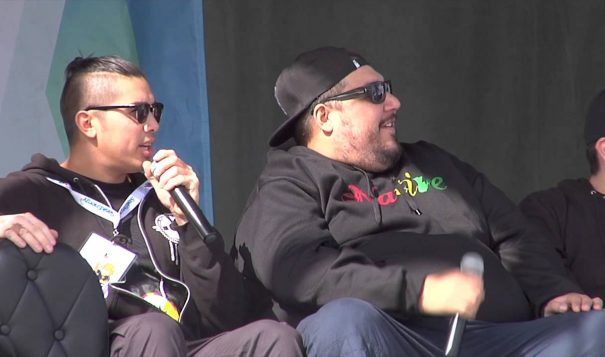 Ryan McMahon with surprise guest Adam Beach on the Red Man Laughing podcast live at the North American Indigenous Games 2014.
Ryan McMahon with surprise guest Adam Beach on the Red Man Laughing podcast live at the North American Indigenous Games 2014.
Some facts: The population of the United States is nearly 40 percent non-white and growing. People of color make up nearly 20 percent of Congress. Nationally, racial or ethnic minorities make up more than a quarter of local police departments; and in Hollywood, characters of color make up almost 30 percent of all film roles.
In journalism, non-white journalists make up only 17 percent of newsrooms.
That means institutions — like Congress — notoriously, or at least stereotypically, bereft of diversity are more inclusive of the nation’s racial and ethnic populations than the industry that prides itself as being a forerunner of justice and foundation of democracy.
Take NPR for instance: Since 2012, NPR’s racial diversity numbers have increased by a single percentage point. According to the New York Times’most recent diversity numbers, the percentage of people of color in staff positions rose to 28 percent in 2017 — up a meager point from 2016. People of color in leadership positions at the paper rose three percentage points from 2015, to 20 percent. In broadcasting, companies have refused to even release diversity numbers, according to a recent study by Harvard’s Shorenstein Center, save for PBS NewsHour, where people of color represent 33 percent of all editorial staff.
Newsroom diversity has been an “official” problem since the release of the Kerner Commission report in 1968. In that report, commissioners criticized the lack of diversity in newsrooms with a particular eye to “race riots” across the country as civil rights became a national issue to white citizens. Fifty years later, a lack of diversity is still a foundational feature of American journalism.
In the case of Hollywood, the response to embarrassing diversity numbers has been public pressure. From #OscarsSoWhite to #whitewashedOUT, the public has put the industry on notice that its practices are unacceptable, and in some cases, straight-up boycotts of ticket sales have helped sink box office hopes and push filmmakers and executives to more equitable territory.
The same tactics should be used in the journalism industry. To start, support the rich world of podcasts, blogs and news outlets that do offer up diverse perspectives. Take Media Indigena, for instance: “When it comes to mainstream coverage of events and issues involving Indigenous peoples, we all too often experience media at their worst,” writes Rick Harp, the podcast’s founder and editor-in-chief. As of today, Media Indigena has 125 episodes ready for download with conversations you will hear nowhere else. They also have this handy index of Indigenous podcasts with listings for everything from Red Man Laughing to Toasted Sister.
The High Country News tribal affairs team also monitors local and national Indigenous news outlets. Mvskoke Media, for instance, covers the Muscogee (Creek) Nation. Navajo Times boasts a team of talented reporters covering the more than 27,000 square miles of the sprawling Navajo Nation. National Native News offers daily stories from across Indian Country, while FNX presents and produces outstanding programming like Wassaja and Studio 49. News From Native California also offers unique stories and perspectives on life in the Golden State while Turtle Talk, a blog for the Indigenous Law and Policy Center at Michigan State University College of Law, is an amazing resources for all things legal in Indian Country. Indianz.com produces and aggregates news from across the country, and Indian Country Today, in its third incarnation, is back online after a brief publishing break, under new ownership, and mobile focused.
A diversity in people creates a diversity in stories. This includes the story of the land you occupy, the story of your neighbors, even the story of this country. In Indian Country, for instance, those stories run contrary, if not in direct opposition, to the narratives found in mainstream outlets.
Exclusion in the journalism industry is more of a tradition than a surprise. On the High Country News tribal affairs desk, we ask you to help diversify news coverage and perspective by putting pressure on mainstream news sources: Start by divesting your attention.
Tristan Ahtone is a member of the Kiowa Tribe and associate editor of the High Country News tribal affairs desk.
